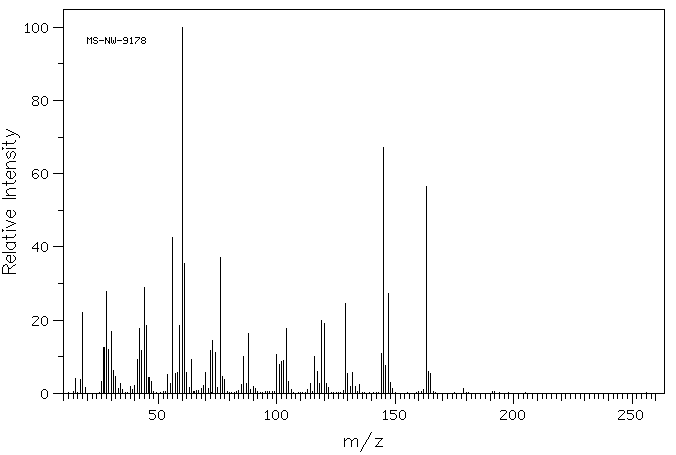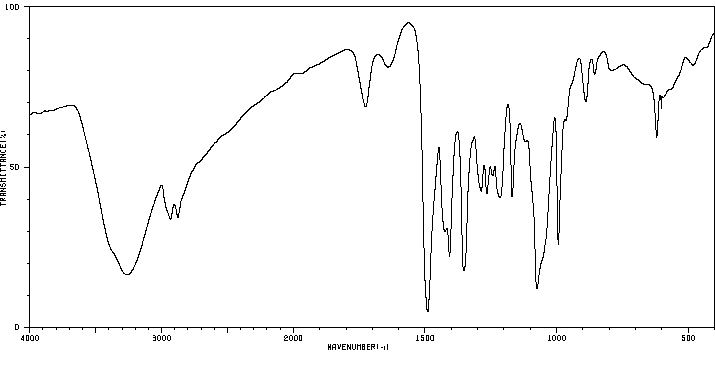双(2-羟乙基)二硫代氨基甲酸铜(II)盐 | 52611-57-1
中文名称
双(2-羟乙基)二硫代氨基甲酸铜(II)盐
中文别名
双(2-羟乙基)二硫代氨基甲酸铜(II);双(2-羟乙基)二硫代甲酸铜;双(2-羟乙基)二硫代氨基甲酸铜
英文名称
copper(II) bis(2-hydroxyethyl)dithiocarbamate
英文别名
Cu(DEDTC)2;Cu(DDC-OH)2;[Cu(Deadtc)2];copper;N,N-bis(2-hydroxyethyl)carbamodithioate
CAS
52611-57-1
化学式
C10H20CuN2O4S4
mdl
——
分子量
424.09
InChiKey
CWZKOKSQKMDNMW-UHFFFAOYSA-L
BEILSTEIN
——
EINECS
——
-
物化性质
-
计算性质
-
ADMET
-
安全信息
-
SDS
-
制备方法与用途
-
上下游信息
-
文献信息
-
表征谱图
-
同类化合物
-
相关功能分类
-
相关结构分类
计算性质
-
辛醇/水分配系数(LogP):-1.79
-
重原子数:21
-
可旋转键数:8
-
环数:0.0
-
sp3杂化的碳原子比例:0.8
-
拓扑面积:154
-
氢给体数:4
-
氢受体数:8
安全信息
-
海关编码:2930909090
SDS
双(2-羟乙基)二硫代氨基甲酸铜(II) 修改号码:5
模块 1. 化学品
产品名称: Copper(II) Bis(2-hydroxyethyl)dithiocarbamate
修改号码: 5
模块 2. 危险性概述
GHS分类
物理性危害 未分类
健康危害 未分类
环境危害 未分类
GHS标签元素
图标或危害标志 无
信号词 无信号词
危险描述 无
防范说明 无
模块 3. 成分/组成信息
单一物质/混和物 单一物质
化学名(中文名): 双(2-羟乙基)二硫代氨基甲酸铜(II)
百分比: >98.0%(T)
CAS编码: 52611-57-1
俗名: Bis(2-hydroxyethyl)dithiocarbamic Acid Copper(II) Salt
分子式: C10H20CuN2O4S4
模块 4. 急救措施
吸入: 将受害者移到新鲜空气处,保持呼吸通畅,休息。若感不适请求医/就诊。
皮肤接触: 立即去除/脱掉所有被污染的衣物。用水清洗皮肤/淋浴。
若皮肤刺激或发生皮疹:求医/就诊。
眼睛接触: 用水小心清洗几分钟。如果方便,易操作,摘除隐形眼镜。继续清洗。
如果眼睛刺激:求医/就诊。
食入: 若感不适,求医/就诊。漱口。
紧急救助者的防护: 救援者需要穿戴个人防护用品,比如橡胶手套和气密性护目镜。
模块 5. 消防措施
合适的灭火剂: 干粉,泡沫,雾状水,二氧化碳
特殊危险性: 小心,燃烧或高温下可能分解产生毒烟。
双(2-羟乙基)二硫代氨基甲酸铜(II) 修改号码:5
模块 5. 消防措施
特定方法: 从上风处灭火,根据周围环境选择合适的灭火方法。
非相关人员应该撤离至安全地方。
周围一旦着火:如果安全,移去可移动容器。
消防员的特殊防护用具: 灭火时,一定要穿戴个人防护用品。
模块 6. 泄漏应急处理
个人防护措施,防护用具, 使用个人防护用品。远离溢出物/泄露处并处在上风处。
紧急措施: 泄露区应该用安全带等圈起来,控制非相关人员进入。
环保措施: 防止进入下水道。
控制和清洗的方法和材料: 清扫收集粉尘,封入密闭容器。注意切勿分散。附着物或收集物应该立即根据合适的
法律法规处置。
模块 7. 操作处置与储存
处理
技术措施: 在通风良好处进行处理。穿戴合适的防护用具。防止粉尘扩散。处理后彻底清洗双手
和脸。
注意事项: 如果粉尘或浮质产生,使用局部排气。
操作处置注意事项: 避免接触皮肤、眼睛和衣物。
贮存
储存条件: 保持容器密闭。存放于凉爽、阴暗处。
远离不相容的材料比如氧化剂存放。
包装材料: 依据法律。
模块 8. 接触控制和个体防护
工程控制: 尽可能安装封闭体系或局部排风系统,操作人员切勿直接接触。同时安装淋浴器和洗
眼器。
个人防护用品
呼吸系统防护: 防尘面具。依据当地和政府法规。
手部防护: 防护手套。
眼睛防护: 安全防护镜。如果情况需要,佩戴面具。
皮肤和身体防护: 防护服。如果情况需要,穿戴防护靴。
模块 9. 理化特性
固体
外形(20°C):
外观: 晶体-粉末
颜色: 深绿色-黑色
气味: 无资料
pH: 无数据资料
熔点: 无资料
沸点/沸程 无资料
闪点: 无资料
爆炸特性
爆炸下限: 无资料
爆炸上限: 无资料
密度: 无资料
溶解度:
[水] 无资料
[其他溶剂] 无资料
双(2-羟乙基)二硫代氨基甲酸铜(II) 修改号码:5
模块 10. 稳定性和反应性
化学稳定性: 一般情况下稳定。
危险反应的可能性: 未报道特殊反应性。
须避免接触的物质 氧化剂
危险的分解产物: 一氧化碳, 二氧化碳, 氮氧化物 (NOx), 硫氧化物, 铜氧化物
模块 11. 毒理学信息
急性毒性: 无资料
对皮肤腐蚀或刺激: 无资料
对眼睛严重损害或刺激: 无资料
生殖细胞变异原性: 无资料
致癌性:
IARC = 无资料
NTP = 无资料
生殖毒性: 无资料
模块 12. 生态学信息
生态毒性:
鱼类: 无资料
甲壳类: 无资料
藻类: 无资料
残留性 / 降解性: 无资料
潜在生物累积 (BCF): 无资料
土壤中移动性
log水分配系数: 无资料
土壤吸收系数 (Koc): 无资料
亨利定律 无资料
constaNT(PaM3/mol):
模块 13. 废弃处置
如果可能,回收处理。请咨询当地管理部门。建议在可燃溶剂中溶解混合,在装有后燃和洗涤装置的化学焚烧炉中
焚烧。废弃处置时请遵守国家、地区和当地的所有法规。
模块 14. 运输信息
联合国分类: 与联合国分类标准不一致
UN编号: 未列明
模块 15. 法规信息
《危险化学品安全管理条例》(2002年1月26日国务院发布,2011年2月16日修订): 针对危险化学品的安全使用、
生产、储存、运输、装卸等方面均作了相应的规定。
双(2-羟乙基)二硫代氨基甲酸铜(II) 修改号码:5
模块16 - 其他信息
N/A
模块 1. 化学品
产品名称: Copper(II) Bis(2-hydroxyethyl)dithiocarbamate
修改号码: 5
模块 2. 危险性概述
GHS分类
物理性危害 未分类
健康危害 未分类
环境危害 未分类
GHS标签元素
图标或危害标志 无
信号词 无信号词
危险描述 无
防范说明 无
模块 3. 成分/组成信息
单一物质/混和物 单一物质
化学名(中文名): 双(2-羟乙基)二硫代氨基甲酸铜(II)
百分比: >98.0%(T)
CAS编码: 52611-57-1
俗名: Bis(2-hydroxyethyl)dithiocarbamic Acid Copper(II) Salt
分子式: C10H20CuN2O4S4
模块 4. 急救措施
吸入: 将受害者移到新鲜空气处,保持呼吸通畅,休息。若感不适请求医/就诊。
皮肤接触: 立即去除/脱掉所有被污染的衣物。用水清洗皮肤/淋浴。
若皮肤刺激或发生皮疹:求医/就诊。
眼睛接触: 用水小心清洗几分钟。如果方便,易操作,摘除隐形眼镜。继续清洗。
如果眼睛刺激:求医/就诊。
食入: 若感不适,求医/就诊。漱口。
紧急救助者的防护: 救援者需要穿戴个人防护用品,比如橡胶手套和气密性护目镜。
模块 5. 消防措施
合适的灭火剂: 干粉,泡沫,雾状水,二氧化碳
特殊危险性: 小心,燃烧或高温下可能分解产生毒烟。
双(2-羟乙基)二硫代氨基甲酸铜(II) 修改号码:5
模块 5. 消防措施
特定方法: 从上风处灭火,根据周围环境选择合适的灭火方法。
非相关人员应该撤离至安全地方。
周围一旦着火:如果安全,移去可移动容器。
消防员的特殊防护用具: 灭火时,一定要穿戴个人防护用品。
模块 6. 泄漏应急处理
个人防护措施,防护用具, 使用个人防护用品。远离溢出物/泄露处并处在上风处。
紧急措施: 泄露区应该用安全带等圈起来,控制非相关人员进入。
环保措施: 防止进入下水道。
控制和清洗的方法和材料: 清扫收集粉尘,封入密闭容器。注意切勿分散。附着物或收集物应该立即根据合适的
法律法规处置。
模块 7. 操作处置与储存
处理
技术措施: 在通风良好处进行处理。穿戴合适的防护用具。防止粉尘扩散。处理后彻底清洗双手
和脸。
注意事项: 如果粉尘或浮质产生,使用局部排气。
操作处置注意事项: 避免接触皮肤、眼睛和衣物。
贮存
储存条件: 保持容器密闭。存放于凉爽、阴暗处。
远离不相容的材料比如氧化剂存放。
包装材料: 依据法律。
模块 8. 接触控制和个体防护
工程控制: 尽可能安装封闭体系或局部排风系统,操作人员切勿直接接触。同时安装淋浴器和洗
眼器。
个人防护用品
呼吸系统防护: 防尘面具。依据当地和政府法规。
手部防护: 防护手套。
眼睛防护: 安全防护镜。如果情况需要,佩戴面具。
皮肤和身体防护: 防护服。如果情况需要,穿戴防护靴。
模块 9. 理化特性
固体
外形(20°C):
外观: 晶体-粉末
颜色: 深绿色-黑色
气味: 无资料
pH: 无数据资料
熔点: 无资料
沸点/沸程 无资料
闪点: 无资料
爆炸特性
爆炸下限: 无资料
爆炸上限: 无资料
密度: 无资料
溶解度:
[水] 无资料
[其他溶剂] 无资料
双(2-羟乙基)二硫代氨基甲酸铜(II) 修改号码:5
模块 10. 稳定性和反应性
化学稳定性: 一般情况下稳定。
危险反应的可能性: 未报道特殊反应性。
须避免接触的物质 氧化剂
危险的分解产物: 一氧化碳, 二氧化碳, 氮氧化物 (NOx), 硫氧化物, 铜氧化物
模块 11. 毒理学信息
急性毒性: 无资料
对皮肤腐蚀或刺激: 无资料
对眼睛严重损害或刺激: 无资料
生殖细胞变异原性: 无资料
致癌性:
IARC = 无资料
NTP = 无资料
生殖毒性: 无资料
模块 12. 生态学信息
生态毒性:
鱼类: 无资料
甲壳类: 无资料
藻类: 无资料
残留性 / 降解性: 无资料
潜在生物累积 (BCF): 无资料
土壤中移动性
log水分配系数: 无资料
土壤吸收系数 (Koc): 无资料
亨利定律 无资料
constaNT(PaM3/mol):
模块 13. 废弃处置
如果可能,回收处理。请咨询当地管理部门。建议在可燃溶剂中溶解混合,在装有后燃和洗涤装置的化学焚烧炉中
焚烧。废弃处置时请遵守国家、地区和当地的所有法规。
模块 14. 运输信息
联合国分类: 与联合国分类标准不一致
UN编号: 未列明
模块 15. 法规信息
《危险化学品安全管理条例》(2002年1月26日国务院发布,2011年2月16日修订): 针对危险化学品的安全使用、
生产、储存、运输、装卸等方面均作了相应的规定。
双(2-羟乙基)二硫代氨基甲酸铜(II) 修改号码:5
模块16 - 其他信息
N/A
反应信息
-
作为反应物:描述:双(2-羟乙基)二硫代氨基甲酸铜(II)盐 、 以 甲醇 为溶剂, 生成参考文献:名称:基于铜-二硫代氨基甲酸酯配合物和PMo12O403-聚阴离子作为新型声催化剂的有机-无机纳米杂化体的声化学合成和结构表征。摘要:通过声化学技术,使用二硫代氨基甲酸铜(II)和Keggin型多钼钼酸盐通过声化学技术制备了一种新的有机-无机纳米杂化化合物[[Cu {(HOCH2CH2)2NCS2} 2] 3 [PMo12O40](1))。 。FT-IR,XRD,FE-SEM,TEM,EDX,UV-Vis,TGA,BET和单晶XRD分析用于描述纳米杂化体组成的特性。化合物(1)由[PMo12O40] 3-结构单元和[Cu {(HOCH2CH2)2NCS2} 2] 1+阳离子部分组成,并施加静电力和充分的氢键相互作用将其堆积。因此,基于单晶X射线衍射图谱制作了三维超分子骨架。FE-SEM和TEM图像证实了纳米杂化样品的形态极具穿透性。该超分子纳米杂化物在作为阳离子有机染料的罗丹明B(RhB)的降解中显示出非常好的声催化性能。结果表明,在存在纳米杂化物(1)和H2O2(4 mmol / L)的情况下,阳离子RhB(25 mgDOI:10.1016/j.ultsonch.2019.104727
-
作为产物:参考文献:名称:由Keggin型多金属氧酸盐和铜-二硫代氨基甲酸酯复合物构建的第一种有机-无机杂化纳米材料:声化学合成,晶体结构及其对有机染料污染物的吸附性能摘要:摘要在本文中,通过二硫代氨基甲酸铜(II)与铜((HOCH2CH2)的反应,制备了一种新型的有机-无机纳米杂化化合物[Cu {(HOCH2CH2)2NCS2} 2] 3 [PW12O40](1)。 )2NCS2} 2,以及Keggin型杂多酸H3PW12O40。通过FT-IR,UV-Vis,扫描电子显微镜(SEM),能量色散X射线光谱法(EDX),Brunauer-Emmett-Teller(BET)方法,热重分析(TG),粉末X表征了纳米杂化物1射线衍射(XRD),元素分析和单晶X射线衍射。1的结构由[PW12O40] 3-结构单元和[Cu(HOCH2CH2)2NCS2)2+阳离子部分组成,它们通过静电力和大量的氢键相互作用堆积在一起,从而建立了三维超分子框架。这种纳米杂化物对阳离子有机污染物表现出非常好的吸附性能。它可以在50分钟内从水溶液中吸收95%的亚甲基蓝(MB)。杂化体1可以容DOI:10.1016/j.poly.2017.01.036
文献信息
-
Peroxy cured (meth)acrylic ester compositions employing metal dithiolate catalysts申请人:LOCTITE CORPORATION公开号:EP0478220A2公开(公告)日:1992-04-01(Meth)acrylic ester formulations employing peroxy initiators have accelerated cure rates when the substrates to which they are applied, or the compositions themselves, include xanthate, dithiocarbamate or dithiophosphate salts of transition metals together with a sulfimide or similar co-accelerator compound.
-
HIGHLY SENSITIVE (METH)ACRYLATE AND RADICALLY CURABLE MATERIAL申请人:AutoNetworks Technologies, Ltd.公开号:EP2960230A1公开(公告)日:2015-12-30Provided is a (meth)acrylate and a radical curable material with which the sensitivity can be enhanced to improve the curability, the increase in viscosity can be suppressed due to good compatibility with various acrylate compounds, and there is no risk that the physical properties of the curable material are deteriorated. The (meth)acrylate has one or more structures represented by Formula 1 in the molecule, and when the (meth)acrylate is used for radical curing, the sensitivity is enhanced. In Formula 1, R1 is a hydrogen atom or a methyl group, R2 is a C1-C10 alkyl chain, R3 is either Formula 2 or 3, and R4 is an alkyl chain constituted by carbon atoms and hydrogen atoms.
-
Curing material, wire harness, and manufacturing method thereof申请人:AUTONETWORKS TECHNOLOGIES, LTD.公开号:US10003177B2公开(公告)日:2018-06-19A curing material, having a solubility parameter of 9.4 or more, contains at least a chain transfer agent that contains a compound containing a polyether structure and two or more urethane bonds or two or more urea bonds in a molecule, and a metal-containing compound. A wire harness is manufactured by supplying the curing material to a conductor exposed portion of a wire bundle including a plurality of bundled insulated wires each having a conductor covered with a covering material made of an insulating body, the conductor exposed portion being formed by removing a part of the covering material of the wire bundle to expose the conductor inside; and curing the curing material by irradiating light in a state in which a surface of the curing material is covered with a protective member formed from a resin containing a plasticizer and having light transmissivity, thereby forming a waterproof portion.
-
Synthesis, characterisation and biological aspects of copper(II) dithiocarbamate complexes, [Cu{S2CNR(CH2CH2OH)}2], (R=Me, Et, Pr and CH2CH2OH)作者:Geraldo M. de Lima、Daniele C. Menezes、Camila A. Cavalcanti、Jaqueline A.F. dos Santos、Isabella P. Ferreira、Eucler B. Paniago、James L. Wardell、Solange M.S.V. Wardell、Klaus Krambrock、Isolda C. Mendes、Heloisa BeraldoDOI:10.1016/j.molstruc.2010.11.048日期:2011.3Cu(II) dithiocarbamates, [CuS2CNR(CH2CH2OH)}(2)], R = Me (1), Et (2), Pr (3) and CH2CH2OH (4), have been prepared from HNR(CH2CH2OH) (R = Me, Et, Pr and CH2CH2OH), CS2 and Cu(OAc)(2). Characterisation of the complexes were generally achieved by infrared and EPR spectroscopies and, in addition, for (2) and (3), by X-ray crystallography at 120K. Complex (2) crystallises as a Cu-S linked dimer, in which the CH2CH2OH groups have a cis arrangement in each monomer but are trans to those in the other monomer partner. On the other hand complex (3) exists in the solid state in the form of two similar and independent centrosymmetric monomers. The weak antiferromagnetic coupling, present in similar complexes, was absent in complexes (1)-(3). The in vitro activity of (1)-(4) was investigated against colonies of Candida albicans, Sthaphyloccocus aureus and Pseudomonas aeruginosa. They all displayed MIC (minimal inhibitory concentration) values against C. albicans close to those found for Fluconazole. All complexes were inert towards Gram-negative or Gram-positive bacteria, S. aureus and P. auruginosa, respectively. (C) 2010 Elsevier B.V. All rights reserved.
-
RADICAL CURABLE MATERIAL申请人:AutoNetworks Technologies, Ltd.公开号:EP2960230B1公开(公告)日:2020-05-06
表征谱图
-
氢谱1HNMR
-
质谱MS
-
碳谱13CNMR
-
红外IR
-
拉曼Raman
-
峰位数据
-
峰位匹配
-
表征信息
同类化合物
(乙腈)二氯镍(II)
(R)-(-)-α-甲基组胺二氢溴化物
(N-(2-甲基丙-2-烯-1-基)乙烷-1,2-二胺)
(4-(苄氧基)-2-(哌啶-1-基)吡啶咪丁-5-基)硼酸
(11-巯基十一烷基)-,,-三甲基溴化铵
鼠立死
鹿花菌素
鲸蜡醇硫酸酯DEA盐
鲸蜡硬脂基二甲基氯化铵
鲸蜡基胺氢氟酸盐
鲸蜡基二甲胺盐酸盐
高苯丙氨醇
高箱鲀毒素
高氯酸5-(二甲氨基)-1-({(E)-[4-(二甲氨基)苯基]甲亚基}氨基)-2-甲基吡啶正离子
高氯酸2-氯-1-({(E)-[4-(二甲氨基)苯基]甲亚基}氨基)-6-甲基吡啶正离子
高氯酸2-(丙烯酰基氧基)-N,N,N-三甲基乙铵
马诺地尔
马来酸氢十八烷酯
马来酸噻吗洛尔EP杂质C
马来酸噻吗洛尔
马来酸倍他司汀
顺式环己烷-1,3-二胺盐酸盐
顺式氯化锆二乙腈
顺式吡咯烷-3,4-二醇盐酸盐
顺式双(3-甲氧基丙腈)二氯铂(II)
顺式3,4-二氟吡咯烷盐酸盐
顺式1-甲基环丙烷1,2-二腈
顺式-二氯-反式-二乙酸-氨-环己胺合铂
顺式-二抗坏血酸(外消旋-1,2-二氨基环己烷)铂(II)水合物
顺式-N,2-二甲基环己胺
顺式-4-甲氧基-环己胺盐酸盐
顺式-4-环己烯-1.2-二胺
顺式-4-氨基-2,2,2-三氟乙酸环己酯
顺式-3-氨基环丁烷甲腈盐酸盐
顺式-2-羟基甲基-1-甲基-1-环己胺
顺式-2-甲基环己胺
顺式-2-(苯基氨基)环己醇
顺式-2-(苯基氨基)环己醇
顺式-2-(氨基甲基)-1-苯基环丙烷羧酸盐酸盐
顺式-1,3-二氨基环戊烷
顺式-1,2-环戊烷二胺二盐酸盐
顺式-1,2-环戊烷二胺
顺式-1,2-环丁腈
顺式-1,2-双氨甲基环己烷
顺式--N,N'-二甲基-1,2-环己二胺
顺式-(R,S)-1,2-二氨基环己烷铂硫酸盐
顺式-(2-氨基-环戊基)-甲醇
顺-2-戊烯腈
顺-1,3-环己烷二胺
顺-1,3-双(氨甲基)环己烷








